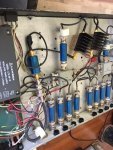Twlighting
Member
Took a gamble and picked up an older Vega 'Diversity Multicoupler' on the cheap to distribute signal from a common antenna to a few RX only radios here. It's comprised of 2 independent 1x4 signal paths. There's very little documentation about these units available, but they were likely used in conjunction with wireless microphone systems or wireless In Ear Monitors for performers.
Though the device itself was originally manufactured as VHF, it had a 10-1000Mhz P-Touch label on it, so pulled the trigger. Sure enough, the device was modified at some point with components covering the 10-1000Mhz range.
Tracing the path from the antenna connector, it appears that the output of the amplifier is sent through a high-pass filter and then onto the antenna. For distributing received signals I would have assumed this would be reversed, sending the amplified signal on to the power divider and subsequent attenuators. Does this look correct?
If this was intended to be used with IEMs (multiple transmitters into a single antenna) this configuration would make more sense to me, but the placement of the high-pass filter after the amplifier seems odd. It's also possible that my theory of operation of these units is incorrect.
Though the device itself was originally manufactured as VHF, it had a 10-1000Mhz P-Touch label on it, so pulled the trigger. Sure enough, the device was modified at some point with components covering the 10-1000Mhz range.
Tracing the path from the antenna connector, it appears that the output of the amplifier is sent through a high-pass filter and then onto the antenna. For distributing received signals I would have assumed this would be reversed, sending the amplified signal on to the power divider and subsequent attenuators. Does this look correct?
If this was intended to be used with IEMs (multiple transmitters into a single antenna) this configuration would make more sense to me, but the placement of the high-pass filter after the amplifier seems odd. It's also possible that my theory of operation of these units is incorrect.





